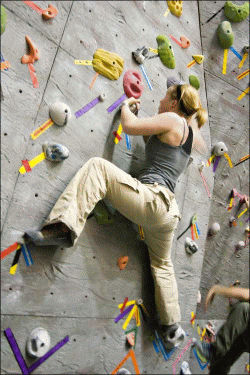Organisations such as Skype provide office pool-tables and foosball (table-soccer); Twitter has a roof-top garden; IT company Drop box offers inter-office scooters and YouTube has an indoor slide…

source: Climbing-the-wall(4) http://www.weplayoutside.com
Sensory strategies are effective in managing individual’s needs for ‘time-out’ to reach optimal performance as part of a team. Companies bring in facilities that promote movement, socialisation and change of focus – not by random introduction of office entertainment but based on well structured choices to counter sensory overload, particularly where people work for long sedentary periods with restricted focus such as at a computer screen, or within the intensity of a call centre.
The choice of movement-breaks or time-out will attempt to meet the needs of people on either end of a continuum – those who require a physical activity to counter the hours of sitting and help them modulate and find balance; and those who need time-out from sensory overload, such as at a quiet rooftop garden or pool where they can change visual field, reduce noise, and enjoy a more relaxing type of exercise such as swimming.
The degree to which you feel energised by the daily experiences of movement, sounds, touch, smell, taste and visual information, or depleted by the cumulative effect of work demands, reflects your own personal threshold of response to sensations in your occupational environment.
Each of us has an individual sensory tolerance for the way we respond and behave. This means that many of our reactions relate more to our biological makeup (‘sensory DNA’) and less to our intention to behave that way…
You may find you are energised by the multiplex demands of everyday life – driving, moving about, taking calls, organising and scheduling activities and events, sales queries, budgets, deadlines; or
alternatively, you may feel overwhelmed and frequently have to stop and recalibrate… and ‘centre’ yourself.
Finding out about your Sensory Profile enables you to manage your own optimal response in everyday life. Those who have a high threshold of response can cope with multiple inputs and variety without this compromising their performance, and they generally need intensity and variety to stay focussed. Those who have a low threshold of response react easily to even a small amount of sensory input; their ability to register a lot of detail makes them excellent at organising, and they are in-tune with every detail in the surroundings, but tend to become easily stressed or overloaded.
The Sensory Profile provides a framework for recognising why some employees prefer structured environments and procedures for complex tasks, while others might prefer the flexibility of a coffee-shop environment, and can multitask amid much noise and people traffic. It also allows us to recognise why we have different responses to task management and to recognise where we are in terms of arousal so as to manage interactions for a positive outcome.
Sensory patterns of behaviour can cause conflict in daily relationships, particularly at meetings where one person’s requirement for sensory intensity by brainstorming various strategies to reach a decision, may cause friction with a colleague who prefers to avoid additional sensory demands restricting discussion to pre-planned agendas and budgets for decision-making.
The key to finding balance is in understanding how we individually, and as team members, respond to different types of sensations. As there is not a lot of scope for individual nuances in a changing work environment, the best approach is to ensure that all employees are able to modulate their level of alertness so as to match the demands of the job.
From a corporate perspective, understanding work demands and balancing this with opportunities for employees to use sensations that are alerting or calming for optimal performance requires creating space and facilities where employees can:
- use sensations to modulate their level of alertness challenging and shifting personal thresholds through the use of movement, calming visual-, sound- or tactile sensation, or use of taste and crunchy texture;
- change environmental contexts such as finding a ‘chill-room’; making adaptations to stressful tasks i.e. number of people on the task, or location; using an i-pod with classical music to override environmental noise; changing to muted background colours on your screensaver; trying different office layouts and partitioning etc
- schedule tasks so as to avoid overload; anticipating situations and taking steps to avoid unnecessary stress;
- set up strategies to reach the ‘just right’ level of alertness for your own optimal performance.
This could include introducing facilities such as an in-house gym or climbing wall that allows you to use resisted movement to modulate stress (movement involves the natural neurological pathways that counter the ‘fight and flight’ stress response) and facilities such as Google’s volleyball courts; or even introducing animals to the office park and gardens.
Awareness of individual differences in sensory response and providing for facilities to allow employees to modulate their alertness and focus is part of the strategy.
Keeping your personnel happy and healthy equips them to manage and cope with productivity and change.
